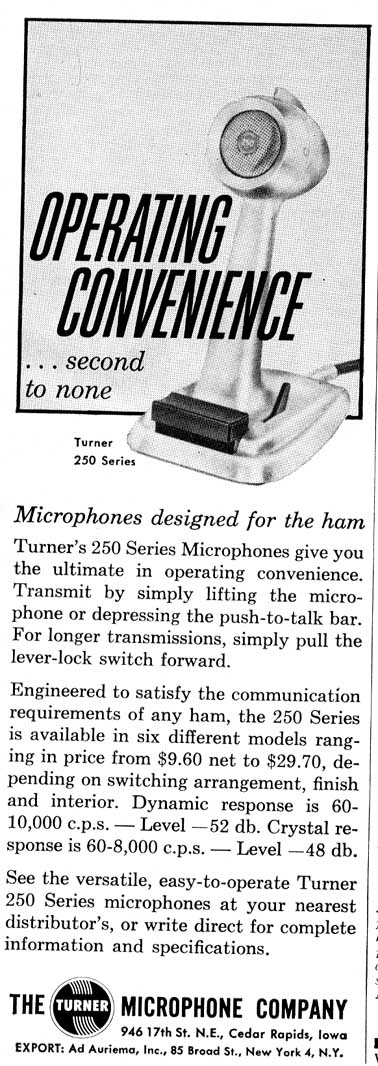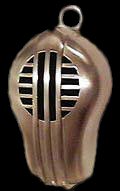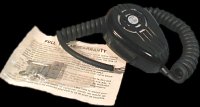
September of 1952 found the company struggling to survive. Microphone sales at about $240,000 were not enough to keep the plant going although subcontract work for Collins Radio helped (The export operation brought in about $100,000 of the mike sales). As microphone companies went, the Turner company ran a poor fourth place among U.S. mike manufacturers (Shure Bros., ElectroVoice, and Astatic). Since the conversion of war production to civilian output, the company tried to expand the product line. The most recent effort was a TV booster in 1951. Result - minimal sales. After years of trying to get a license from Brush Development to make crystal phonograph cartridges (standard items with the other mike companies), Turner succeeded, only to find the industry shifting to magnetic units which was just another disappointment.
Turner's next attempt, a
TV UHF converter in 1954, was also a disappointment as they entered
too late into a market loaded with excess inventories, while
UHF stations around the country failed, one after another. With
the company’s resources dangerously thin and 2,500 converters
in inventory, sales totaled 12 units.
Amazingly, the entire inventory
and the balance of the 5,000 unit production run were sold to
Milwaukee distributors in the first week of September. That turned
out to be the only market penetrated, and eventually swallowed
up 15,000 Turner converters bringing in half a million dollars
- At last! Although the converter success helped turn the first
profit in years, it didn’t cure the basic problem: Turner
couldn’t live on microphones alone.
With the UHF boom over, once again the marketing of microphones became the challenge. The companies sales force, about fifteen rep organizations, was well established throughout the country, many of them with Turner fifteen or twenty years. Nearly all sales were to radio parts distributors, who found their customers among ham operators, commercial sound installers, and other owners of amplifiers, radio transmitters, and broadcast transmitters which was a limited market.
The decision to go after the OEM business, especially the rapidly growing tape recorder market, was the turning point and it paved the way for an surprising reversal. Companies that made devices that required a microphone rarely built their own. The reel-to-reel tape recorder market exploded in the late fifties, and Turner began designing small ceramic microphones, inexpensive and complete with a cloth-covered cable and RCA phono plug (much of this business involved private labeling, designing and building a mike to customer specs).
After a 24-year struggle, came the beginning of the golden age! Instead of distributor orders for fifteen mikes, these OEM accounts were bought by the thousand. Wilcox-Gay, later known as Recordio, Telectro, Heath, Webster Electric, and the VM corporation – names mostly forgotten – had a brief day in the sun, and it was the beginning of the Turner success. The growth of products that required a microphone was a major factor in this success story. Turner made tens of thousands of microphones for the tape recorder industry, most of them private labeled, custom built. Dictating machine companies – Dictaphone, IBM, and others designed their case and Turner built the mike cartridge. Largest of all these was the leader in two-way radio, Motorola.. As a single source, Turner built about 30,000 units a year for Motorola in the late sixties and early seventies.
Sales hit the million-dollar mark in 1955 for the first time (nearly four million at the time of the sale to Conrac in 1968). They continued upward, to $7.5 million in ’75, $15 million in ’76, and $35 million before the CB market died and Telex bought the remains.

Before the final boom and crash of the CB business, there were two developments in our cultural history that brought the distributor business back into play: Rock bands and the Catholic Church!
In the sixties, Rock music bands exploded onto the scene and began to demand high quality, broadcast-type mikes – often four at a crack. The Turner model 500 became a standard.
During this period, the Catholic church replaced Latin with English in all services which translated into a need for amplified sound where it had not been necessary before. The Turner gold-plated cardioid, with the appropriate cross on the nameplate, generated new business for Turner distributors nationwide.
Finally, I come to the Citizens
Band radio market, which was the mother lode for Turner. In the
beginning of the Citizens Band Radio Service, there was skepticism
on the part of many suppliers, especially the mike people, about
whether or not it was worth entering the market. Turner, still
in fourth place among the mike companies, jumped in early with
a cobbed-up tape recorder mike – a ceramic model that sold
in 10,000 quantities at $1.67. But, it had to have a switch and
coiled cord – and the price went to $3.90. All of the tear-drop,
hand-held models (ala Motorola) made by the mike companies were
die-cast metal cases and cost seven to nine dollars.

Early CB sets used the little tape recorder mike, but not for long. Turner designed a plastic case tear-drop model, made an operating sample, and went after the business. That hand made mike from the Turner model shop languished in a sales manager

That was the model 350C.
Hallicrafters, a ham radio manufacturer in Chicago, actually
placed the first order, to be used with a marine radio built
for RCA. Tooling finished, the mike hit the market and by the
end of six months, eighteen of the early 22 makers of CB transceivers
had the 350C on their radios – all private label, in a variety
of colors and nameplates.
But wait - it wasn't over! The company introduced the first power mike, the Plus 2, which was a base station model complete with a press-to-talk switch, battery, and volume control to adjust the modulation. The die-cast case was a standard part of the commercial sound line, Model 250 series, and the +2 for the CB market was painted blue. It was an immediate success. Meanwhile, the original CB mike (350C) was replaced by a new version (355C) and with the CB market expanding rapidly, that model became the standard replacement for thousands of CB’ers.
The clamor for a mobile CB mike with a modulation control took the company into the final step of its success story, as the M+2 was introduced. The new case looked like a cake of soap, but it became the single most popular mike Turner ever made, and dominated the replacement business until the crash.
Well into the CB boom in
the early seventies, Turner engineered a line of CB antennas
with production set up at the Cramer division of Conrac. The
SignalKicker antennas were quickly established
and within a year ranked third in the country behind Antenna
Specialists and HyGain. Again, the distributor business expanded
as hundreds of new outlets began ordering large quantities of
CB mikes. At the peak of the boom – early 1976 – the
largest distributors placed standing orders for thousands of
mikes to be shipped each month. Production increases failed to
keep up with the demand, and the lead time grew to four or five
months.
There’s
an interesting background story to the end of the Turner company.
After the years of struggling ended and debt had been erased,
the cash position grew to the point that a decision was made
to buy another company. After two or three efforts failed, that
project was dropped, only to be replaced a year later with a
decision to sell. The first offer came from Amphenol, a connector
company; the second, Telex Corporation, and the third, the Conrac
Corporation. Turner became a division of Conrac and in 1979,
Conrac sold the division to – you guessed it – Telex.
|
|
|
Ed. - Tom Moss worked for the Turner Company for many years and certainly details the rise of Turner in the 1952-End years. As Tom suggest, check out Eric site for some great photo's, newspaper articles, and a look into Turner's earlier history. You can reach Eric's site via the links above or through my Turner page |